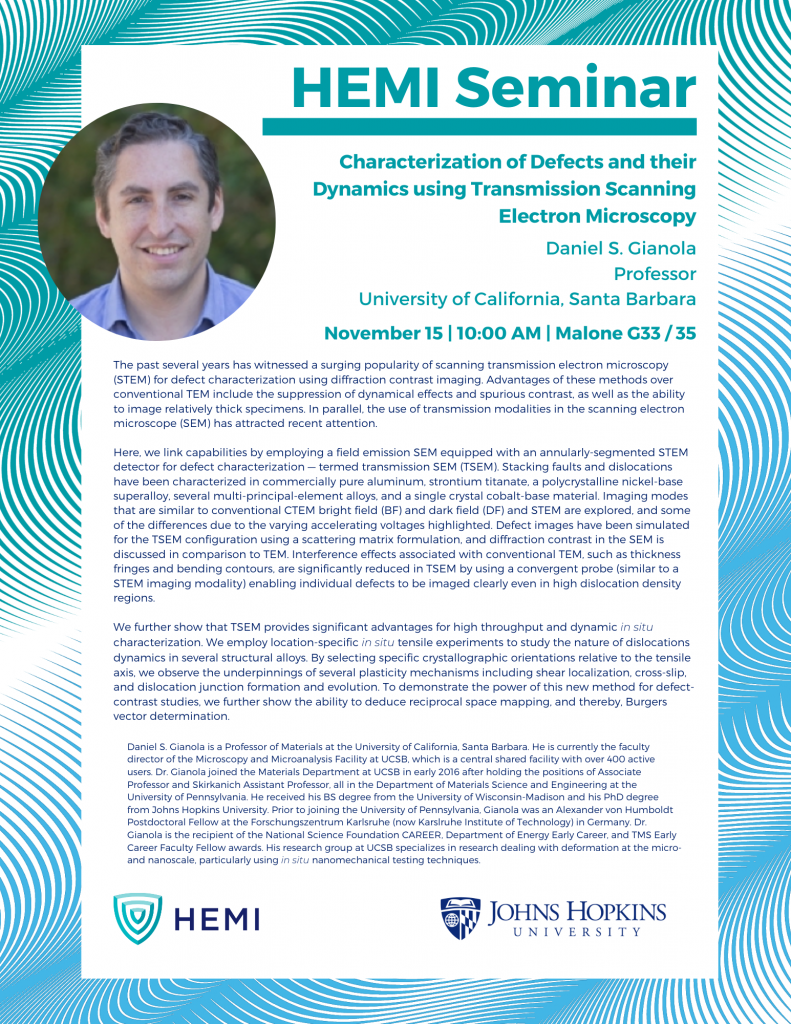November 15, 2019 @ 10:00 am - 11:00 am
Event Navigation
Characterization of Defects and their Dynamics using Transmission Scanning Electron Microscopy
Daniel S. Gianola
Materials Department, University of California Santa Barbara
The past several years has witnessed a surging popularity of scanning transmission electron microscopy (STEM) for defect characterization using diffraction contrast imaging. Advantages of these methods over conventional TEM include the suppression of dynamical effects and spurious contrast, as well as the ability to image relatively thick specimens. In parallel, the use of transmission modalities in the scanning electron microscope (SEM) has attracted recent attention.
Here, we link these capabilities by employing an field emission SEM equipped with an annularly-segmented STEM detector for defect characterization – termed transmission SEM (TSEM). Stacking faults and dislocations have been characterized in commercially pure aluminum, strontium titanate, a polycrystalline nickel-base superalloy, several multi-principal-element alloys, and a single crystal cobalt-base material. Imaging modes that are similar to conventional CTEM bright field (BF) and dark field (DF) and STEM are explored, and some of the differences due to the varying accelerating voltages highlighted. Defect images have been simulated for the TSEM configuration using a scattering matrix formulation, and diffraction contrast in the SEM is discussed in comparison to TEM. Interference effects associated with conventional TEM, such as thickness fringes and bending contours, are significantly reduced in TSEM by using a convergent probe (similar to a STEM imaging modality) enabling individual defects to be imaged clearly even in high dislocation density regions.
We further show that TSEM provides significant advantages for high throughput and dynamic in situ characterization. We employ location-specific in situ tensile experiments to study the nature of dislocations dynamics in several structural alloys. By selecting specific crystallographic orientations relative to the tensile axis, we observe the underpinnings of several plasticity mechanisms including shear localization, cross-slip, and dislocation junction formation and evolution. To demonstrate the power of this new method for defect-contrast studies, we further show the ability to deduce reciprocal space mapping, and thereby, Burgers vector determination.
Daniel S. Gianola is a Professor of Materials at the University of California Santa Barbara and can be reached at: [email protected]. He is currently the faculty director of the Microscopy and Microanalysis Facility at UCSB, which is a central shared facility with over 400 active users. Dr. Gianola joined the Materials Department at UCSB in early 2016 after holding the positions of Associate Professor and Skirkanich Assistant Professor, all in the Department of Materials Science and Engineering at the University of Pennsylvania. He received a BS degree from the University of Wisconsin-Madison and his PhD degree from Johns Hopkins University. Prior to joining the University of Pennsylvania, Gianola was an Alexander von Humboldt Postdoctoral Fellow at the Forschungszentrum Karlsruhe (now Karlsruhe Institute of Technology) in Germany. Dr. Gianola is the recipient of the National Science Foundation CAREER, Department of Energy Early Career, and TMS Early Career Faculty Fellow awards. His research group at UCSB specializes in research dealing with deformation at the micro- and nanoscale, particularly using in situ nanomechanical testing techniques.





